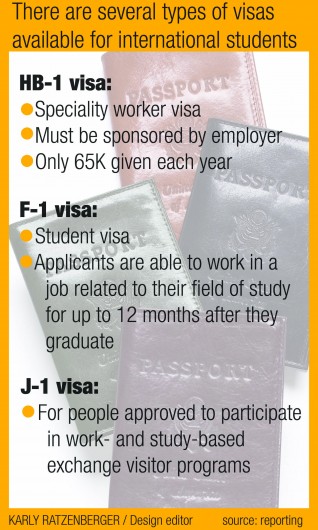The biggest issue some Ohio State international students said they face doesn’t have to do with their time enrolled at the university.
Devon Zhao, a fourth-year undergraduate studying human resources who transferred to OSU two years ago from a Chinese school, has big plans for the future, but those plans could be shattered if she cannot obtain the necessary visa to work in the United States post-graduation.
“I feel like it is the biggest problem international students face,” she said.
There were 6,039 international students enrolled at OSU this past fall, out of a total 63,964 students enrolled at all levels and all campuses, according to the student enrollment report.
Gifty Ako-Adounvo, OSU international students and scholar services director, said the process to obtain a worker’s visa isn’t one students can typically embark on alone.
“The H1-B is a specialty worker visa, and there is a specific number that the U.S. citizenship and immigration services through the government has available each year. There is a cap of 65,000 H1-Bs each year,” Ako-Adounvo said. “The H1-B is an employer-sponsored visa, so it is not something a student that graduates from here who gets a job can apply for. It has to be done by the employer.”
The other temporary worker visas the U.S government grants mostly cover specific occupations, including agricultural workers, athletes and entertainers, as well as intracompany transfers and participants in an international cultural exchange program, according to the U.S. Department of State’s visas website.
With the cap on how many are distributed per fiscal year and a graduate’s inability to apply themselves, the visas can be hard to come by for students. That can in turn cause students to worry — something Zhao has experienced since she looks to graduate in spring 2015.
“I feel like for most of the international students, we’re really stressed out,” Zhao said.
Zhao wants to stay in the U.S. after graduating, although she knows it might not be easy.
“I know it’s really hard, but you have to just go for it and really be patient and just keep trying,” she said. “I think (my reason for wanting to stay in the U.S.) is really related to my major, because my major is human resources, and there’s a lot of things about law and everything’s different since you learned all the HR system here … If I go back to China, I have to learn the whole thing again.”
Obtaining an H1-B visa might be difficult, but there is one tool built into students’ F-1 visas to help them stay in the U.S. and work temporarily.
“One of the benefits of the F-1 status is that they are able to work in a job related to their field of study for up to 12 months after they graduate,” Ako-Adounvo said.
That aspect of the visa is called Optional Practical Training.
“Students who are (employed) in certain (STEM) fields can actually get an additional 17 months,” Ako-Adounvo added.
Science, technology, engineering and mathematics related fields are often grouped together into the category STEM.
While F-1 visas are the most common choice for international students coming to OSU, some choose J-1 or other visas, Ako-Adounvo said. J-1 visas are for people “approved to participate in work- and study-based exchange visitor programs,” according to the U.S. government J-1 visa website.
Gefei Liu, a fourth-year in finance who expects to graduate this spring, currently has an F-1 visa. She wants to stay in the U.S. after graduation and find a job in a company’s finance department, but is worried about getting a visa to stay.
“I’m concerned because not a lot of employers want to sponsor international students for a visa,” Liu said. “(But) I like the environment here (and) I think China’s finance system might be different from the United States.”
She said she plans to use the OPT and then ask her future employer to sponsor a visa for her.
Some international students, though, don’t try to stay in the U.S. at all after graduating.
Rahul Shrivastava, who graduated from OSU in 2013 with a degree in business administration and lives in India, said he chose not to stay post-graduation.
“The reason I decided to study in the U.S. was because I wanted to experience a foreign culture and grow as a individual,” Shrivastava said in an email. “I did not want to stay back and work in the U.S. because I had different interests I wanted to pursue in India … Currently I’m interning in a film studio in Hyderabad, India.”
Zhao said if her visa plans go awry, she has a fallback plan to work for 12 months with the OPT and enroll in graduate school in order to stay in the country and not have to return to China.
“I always have that feeling that I’m going to get lucky, but we’ll see,” she said.



